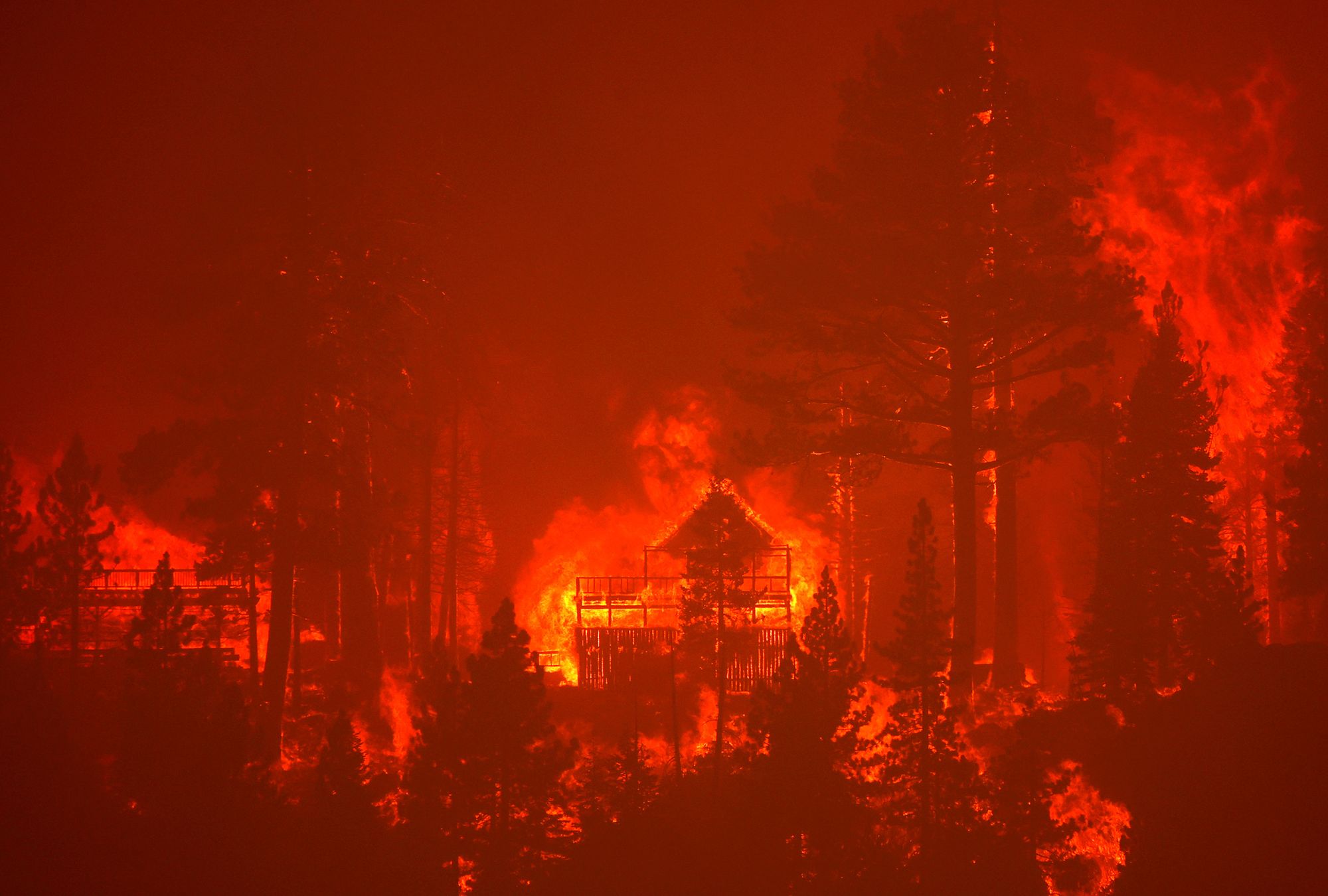The Caldor Fire continued its steady advance toward the Tahoe Basin on Monday amid a mass evacuation of South Lake Tahoe. But while spot fires have made it into Christmas Valley and the community of Meyers, most of the flames have so far been held back by the granite outcroppings around Lower Echo Lake and Lake Aloha.
The fire grew to 191,607 acres overnight, up from 177,260 acres on Monday morning, and as Cal Fire Chief Thom Porter said in an update, per Bay Area News Group, the fire advanced about eight miles since yesterday. Its northeastern front now sits just six miles outside South Lake Tahoe, and the fire was just 16% contained as of this morning.

"There is fire activity happening in California that we have never seen before," Porter said.
Chris Anthony, Cal Fire’s assistant deputy director of cooperate fire protection, training, safety and emergency medical services, tells Bay Area News Group that the drought and recent wind conditions have contributed to the "resistance to control that we’re seeing with the Caldor Fire."
He added that, given climate change and the areas of desiccated forest that have not burned for so long, none of this can be considered anomalous anymore.
A massive traffic jam formed Monday as South Lake Tahoe residents attempted to flee the area on eastbound Highway 50 toward Nevada, lasting at least three hours as cars inched along. At one point, as KRON4 reports, area resident Mel Smothers got out of his car in standstill traffic and played his violin to help pass the time for the people stuck in cars around him.
South Lake Tahoe resident Ken Breslin likely echoes the thoughts of many area residents, speaking to ABC 7, when he explains that up until Monday, it seemed like Cal Fire crews were going to keep the Caldor Fire from cresting over the ridges and entering the Tahoe Basin.
"Before, it was, 'No worries ... it's not going to crest. It's not gonna come down the hill. There's 3,500 firefighters, all those bulldozers and all the air support,'" Breslin tells the station. "Until this morning, I didn't think there was a chance it could come into this area. Now, it's very real."
Approximately one-third of Lake Tahoe's shoreline is now under an evacuation order, and if the Caldor Fire succeeds in fully engulfing the area, it will be the first fire to do so in more than a century. The last fire to hit South Lake Tahoe was the Angora Fire in 2007, but it was contained at just 3,100 acres — though it destroyed 280 buildings.
Heavenly, Kirkwood, and Sierra-at-Tahoe ski areas are all threatened by flames, with the latter having served as a staging area for firefighters beating back the flames over the weekend.
Also threatened are multiple beloved camps and scenic areas in the southern part of the lake, including Emerald Bay, D.L. Bliss State Park, Rubicon Point, Sugar Pine State Park, Berkeley Camp, and Camp Richardson.


"Everybody is pretty on edge," says Geoffrey Schladow, a professor of engineering at UC Davis and director of the Tahoe Environmental Research Center, speaking to Bay Area News Group. Schladow says that if the flames crest the ridges where they are now, ash and embers will likely begin raining into the lake itself, threatening the lake's clarity and ecosystem.
"You always thought maybe it won’t happen. But it’s getting close to happening," Schladow says.
The Dixie Fire currently burning north of the Tahoe area, and the Caldor Fire, mark the first two times in recorded California history that wildfires have burned from one side of the Sierra to the other. This disheartening milestone is just further evidence of what had for many months been forecast to be a historically terrible fire season in the state.
The Caldor Fire has also prompted evacuation warnings in Douglas County, Nevada, across the state line from South Lake Tahoe — and Nevada Governor Steve Sisolak declared a state of emergency for the area in "anticipation" of the fire.
El Dorado County, which includes South Lake Tahoe, has been under a state of emergency since August 17.
The next day or so will prove critical in terms of keeping the fire from spreading further toward the lake's edge. As the National Weather Service reports, the same south to southwest winds that fanned the fire's flames on Monday are expected to continue through Tuesday.
Related: New Evacuation Orders Hit Most of South Lake Tahoe as Caldor Fire Inches Closer
Top image: Mel Smothers playing his violin in traffic on August 30, 2021. Photo by Justin Sullivan/Getty Images

